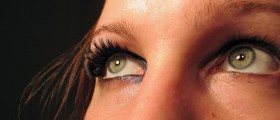When double vision, or diplopia, occurs, it results in two images of a single object appearing before the eyes. The underlying cause of diplopia will depend on whether the double vision is a binocular or monocular problem. If you do develop double vision, you should consult a doctor as soon as possible, as it may be a symptom of a more serious underlying question.
Eye Nerves and Muscles
The brain controls the eye muscles in order to ensure that both eyes are correctly focused on the targeted object. The two separate images the eyes collect are molded together by the brain in order to form a single image. If the eye muscles or nerves become damaged, then eyes may not be able to be controlled properly. This can lead to double vision. Eye muscles can be weakened by a health condition. The eyes may also be incorrectly aligned, thus causing a squint.

Causes of Double Vision
If double vision occurs in only one eye, then vision should be corrected when the affected eye is covered. With monocular double vision, the collected images are usually only slightly different. Monocular double vision might be caused by astigmatism, dry eye, corneal abnormalities, cataracts or retinal abnormalities. The condition is quite rare, and the most common causes are astigmatism and cataracts.
When both eyes are vulnerable to double vision, this is known as binocular double vision. Vision will usually be normal if one eye is covered. Binocular double vision is the more common occurrence of double vision. This condition causes the eyes to point in different directions, thus making it impossible for the brain to reconcile the two images. When the eyes look in different directions, this is known as a squint. Not all squints cause double vision, however. In those who have a squint the muscles in the eyes are normally weak, too strong restricted. This condition is common in children.
- There are several binocular diplopia etiological mechanisms: (1) orbital disorder; (2) extraocular muscle disorder; (3) neuromuscular junction dysfunction; (4) third, fourth, and sixth cranial nerve palsy; and (5) injury of the central nervous system.
- Another less frequent cause, yet mentioned in the binocular diplopia literature, is diplopia caused by drugs.
- The onset of diplopia is usually sudden, but this does not necessarily indicate vascular pathology.
- Monocular diplopia is less frequent (11%) and may be caused by refractive errors, corneal disease (e.g., irregular astigmatism), iris lesion, cataracts, and macular disease. Primary or secondary visual cortex diseases are rarely associated with monocular diplopia or cerebral polyopia (seeing more than 2 images).
There are some conditions that can also lead to double vision. For example, if you suffer from a thyroid condition, this might affect the external eye muscles. There are some conditions that affect the blood vessels supplying the brain. These conditions can also affect the nerves that control the eye muscles. Stroke and transient or ischemic attack are examples of these conditions.
Diabetes can also lead to double vision as a result of damaged blood vessels. Other conditions include myasthenia gravis, which causes muscle weakness, multiple sclerosis, which affects the central nervous system. Aneurysms, brain tumors, cancer and head injuries can all contribute to the onset of double vision.

















Your thoughts on this
Loading...